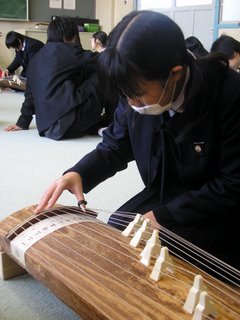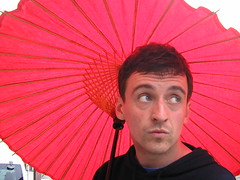Some observations...
I spent the whole of last week at one school, outside of which, road-works were taking place. They were just starting when I arrived at 8:15...by the time I left at 17:15, not only had they finished, the workmen had tarmacked over the hole they left. I walked home amazed at the Japanese work ethic, and less so at the speed with which the nation industrialised. The next day however, I came to work to find that they'd ripped up that particular bit of tarmac in order to do more work...at the end of that day, they tarmacked over the hole again...and again the next day...mid afternoon breaks to the vending machine granted me the sight of workmen using the very latest in road gnashing technology, whilst their colleague sweeps up the detritus with a witches broom. Japan was nicely summed up in that dance of diggers - dilligence, extravagant use of resources and the very new co-existing with the very old.
 Keeping with this idea of a polarisation of Japanese culture (and I can't believe I've only ever alluded to this) is the fact that the Japanese can either be polite to a fault or the rudest people on the planet. This is probably down to the fundamentally Japanese concepts of uchi (inside) and soto (outside). I'll go into more detail in another entry, but put simply, the Japanese will have several uchi groups (the home, job, social club etc) and if you are outside of that group (soto) you may as well not exist...this idea was demonstrated fiercely on
Keeping with this idea of a polarisation of Japanese culture (and I can't believe I've only ever alluded to this) is the fact that the Japanese can either be polite to a fault or the rudest people on the planet. This is probably down to the fundamentally Japanese concepts of uchi (inside) and soto (outside). I'll go into more detail in another entry, but put simply, the Japanese will have several uchi groups (the home, job, social club etc) and if you are outside of that group (soto) you may as well not exist...this idea was demonstrated fiercely on  sunday, the Chinese New Year (of the Dog) in Yokohama (pictured).
sunday, the Chinese New Year (of the Dog) in Yokohama (pictured). So many people, all jostling for a space to take photos, so few prepared to test their patience...even my chivalric "ladies first" attitude towards the elderly was met with a wrinkly elbow to the groin, although that could have been something to do with the womans' size...and the hundreds of other people scrambling for a good spot.
I've almost been feeling belligerent towards the Japanese recently, maybe due to the onset of a secondary culture shock, but it's not all bad. Today I've been teaching at an elementary school that is the first in Kawasaki to call in volunteers from the local community to help with lessons.
 As it's a school very close to where I live, I now know a few more of my neighbours, which is very nice as I teach their children - feels like I'm becoming a sort of member of an uchi...that aside, this school is a lot of fun. Each grade is taught en masse in the gym, sometimes with costumes. There I'm wearing part of the attire of the popular TV comedy character Hard Gay. As it's elementary school, English skills are limited, but I've become friends with three fifth grade boys who've made me a member of the Penguin Club, whatever that entails...
As it's a school very close to where I live, I now know a few more of my neighbours, which is very nice as I teach their children - feels like I'm becoming a sort of member of an uchi...that aside, this school is a lot of fun. Each grade is taught en masse in the gym, sometimes with costumes. There I'm wearing part of the attire of the popular TV comedy character Hard Gay. As it's elementary school, English skills are limited, but I've become friends with three fifth grade boys who've made me a member of the Penguin Club, whatever that entails...So, in closing, I heard a Japanese childrens song courtesy of Matt the ALT the other week, and it's been bringing me almost endless delight since then...it's about a white goat who writes a letter to his friend the black goat.
Unfortunately the black goat eats the letter when he receives it. Later, the black goat wonders what was in the letter he ate, so he writes one to the white goat, asking him.
Unfortunately the white goat eats the letter when he receives it. Later, the white goat wonders what was in the letter he ate, so he writes one to the black goat asking him.
Unfortunately the black goat eats the letter when he receives it. Later, the black goat wonders what was in the letter he ate, so he writes one to the white goat asking him.
Unfortunately the white goat eats the letter when he receives it. Later, the white goat wonders what was in the letter he ate, so he writes one to the black goat asking him.
Unfortunately the black goat eats the letter when he receives it. Later, the black goat wonders what was in the letter he ate...
Labels: anger, cool places, culture (shock), folklore, I wasn't expecting that, Japan, school, teaching, that job they make me do




























